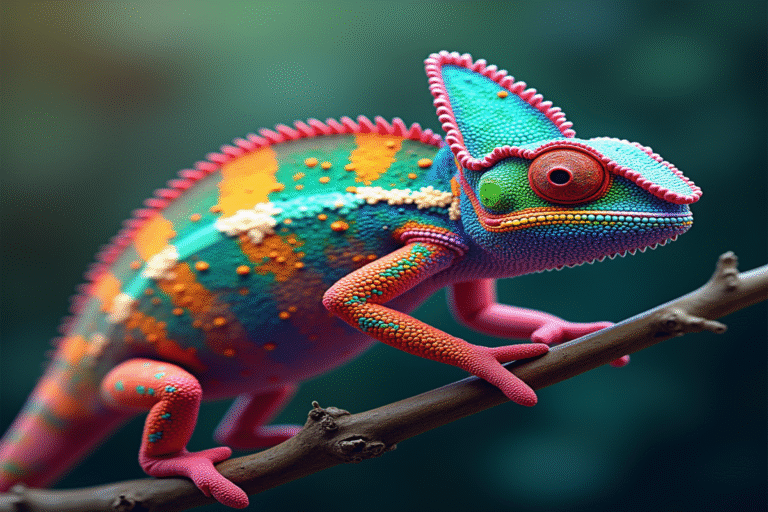When you see a chameleon slowly change from green to a brilliant blue or fiery red, you’re witnessing one of nature’s most misunderstood wonders. Contrary to what cartoons suggest, these color-changing reptiles are not just living versions of mood rings. Even more astonishing, they don’t use pigments to create their dazzling displays—instead, they manipulate light in ways that would amaze physicists.
Shattering the Chameleon Myth
Let’s clear something up right away: chameleons don’t primarily change color to blend into their surroundings. That widely believed “fact” is actually a misconception. Their color transformations are mainly communication tools—used to attract mates, warn rivals, or signal emotional states. And the mechanism behind these changes is more fascinating than most people realize.
The Breakthrough Discovery
In 2015, a team of scientists led by Michel Milinkovitch at the University of Geneva published a groundbreaking study in Nature Communications revealing something extraordinary: chameleons use sophisticated nanoscale structures to change color, not pigments. This discovery completely changed our understanding of chameleon biology.
While most color-changing animals—like squids and octopuses—depend on expanding and contracting pigment cells, chameleons evolved a completely different method. One that puts human technology to shame.
The Nanoscale Marvel: How It Actually Works
Beneath a chameleon’s skin are specialized cells called iridophores containing tiny crystals made of guanine—the same molecule found in DNA. These crystals are arranged in a precise lattice, each measuring around 100 nanometers. To put that in perspective, if a guanine crystal were the size of a tennis ball, a human hair would be as wide as a tennis court!
The true genius of this system is that chameleons can actively adjust these nanocrystal lattices by relaxing or exciting their skin cells. When the chameleon is calm, the crystals form a dense network that reflects shorter wavelengths, producing blues and greens. When excited, the lattice expands, spacing the crystals farther apart, which shifts the reflection toward longer wavelengths—yielding yellows, oranges, and reds.
It’s like a microscopic prism that can change its properties on demand. It’s not pigment mixing like paint—it’s the physical manipulation of light waves!
Beneath these crystal-containing cells lies another layer with melanin (the same pigment found in human skin). This dark background enhances the structural colors above, just like jewelers display gemstones on black velvet to make them appear more brilliant.
Why Chameleons Really Change Color
Now that we know how chameleons change color, let’s look at why they do it. The reasons are more nuanced than simple camouflage:
- Social signaling: Males display brilliant colors to attract females or to warn rival males
- Emotional expression: Colors can indicate stress, fear, relaxation, or aggression
- Temperature regulation: Darker colors absorb more heat, helping chameleons warm up when cold
- Communication: Different color patterns act as a sophisticated “visual language”
When a male panther chameleon transforms from a relaxed green to a vibrant pattern of reds and yellows upon seeing a female, he’s not trying to hide—he’s putting on one of nature’s most spectacular light shows!
Nature’s Engineering Masterpiece
The chameleon’s color-changing ability represents a biological technology that scientists have only recently begun to replicate in laboratories. Researchers have been developing photonic crystals for decades, but chameleons evolved this brilliant system millions of years ago through natural selection.
The precision is remarkable: different patches of a chameleon’s skin can display different colors at the same time, creating complex patterns that shift and change independently. This requires neural control so sophisticated that scientists are still working to fully understand it.
Materials scientists and physicists are now studying chameleon skin to inspire new technologies that could change our world:
- Display screens that work without electricity
- Smart fabrics that change color based on temperature or other conditions
- Advanced camouflage that adapts to its surroundings
- New types of sensors that visually respond to environmental changes
Mind-Blowing Chameleon Facts
Here are some facts about chameleon color change that might surprise you:
- The fastest color-changing chameleons can completely alter their appearance in just 20 seconds
- Some species can reflect ultraviolet light, creating “secret colors” visible only to other chameleons and certain birds
- A panther chameleon’s skin contains two distinct layers of light-manipulating crystals, allowing for an even more vibrant range of colors
- When a chameleon is stressed or ill, its ability to change color weakens, since the mechanism requires active cellular control
- If you extracted and preserved the guanine crystals from chameleon skin, they would continue to display structural colors even without the living chameleon
- Male chameleons generally have much more dramatic color-changing abilities than females, due to sexual selection
Masters of Light Manipulation
What’s fascinating is that chameleons aren’t passive color reflectors. They’re actively manipulating physical properties at the nanoscale level to control how light interacts with their skin. This ability requires not just the right nanostructures, but also the neural wiring to control them with precision.
Some species, like the panther chameleon of Madagascar, can produce almost the entire visible spectrum of colors using this mechanism, creating some of the most vivid displays in the animal kingdom. And they do all this without changing pigment!
Nature’s Lessons in Innovation
The next time you see a chameleon shift from emerald green to blazing orange, remember you’re witnessing something far more advanced than a simple color change. You’re observing a masterclass in photonic engineering—a living demonstration of advanced physics that shows how innovation in nature often comes before and inspires human technology.
Chameleons have been perfecting their remarkable light manipulation abilities for millions of years, quietly teaching us that sometimes the most extraordinary technologies are not invented in laboratories, but discovered in the evolutionary adaptations of creatures that have been solving complex problems long before humans existed to admire their brilliance.





